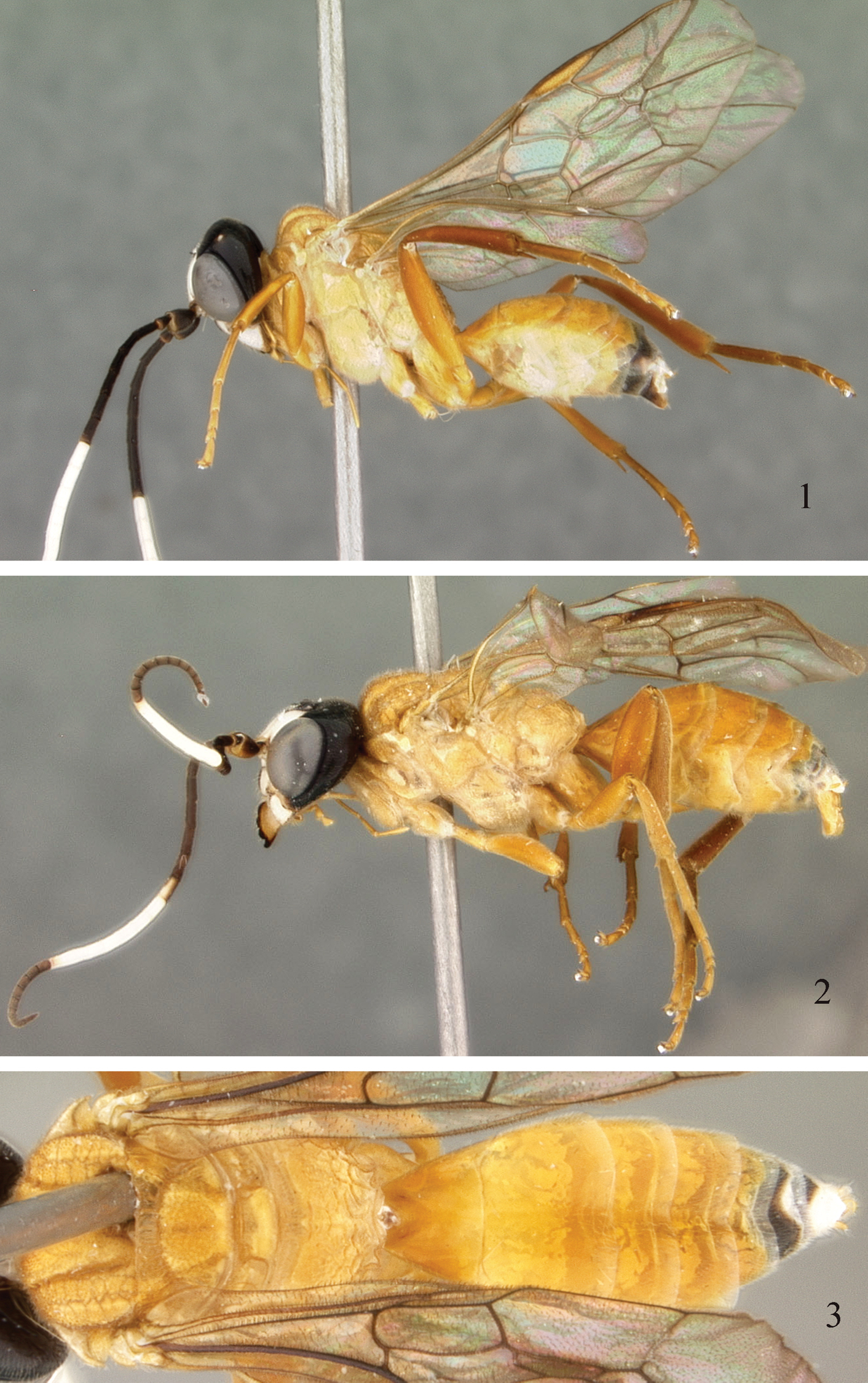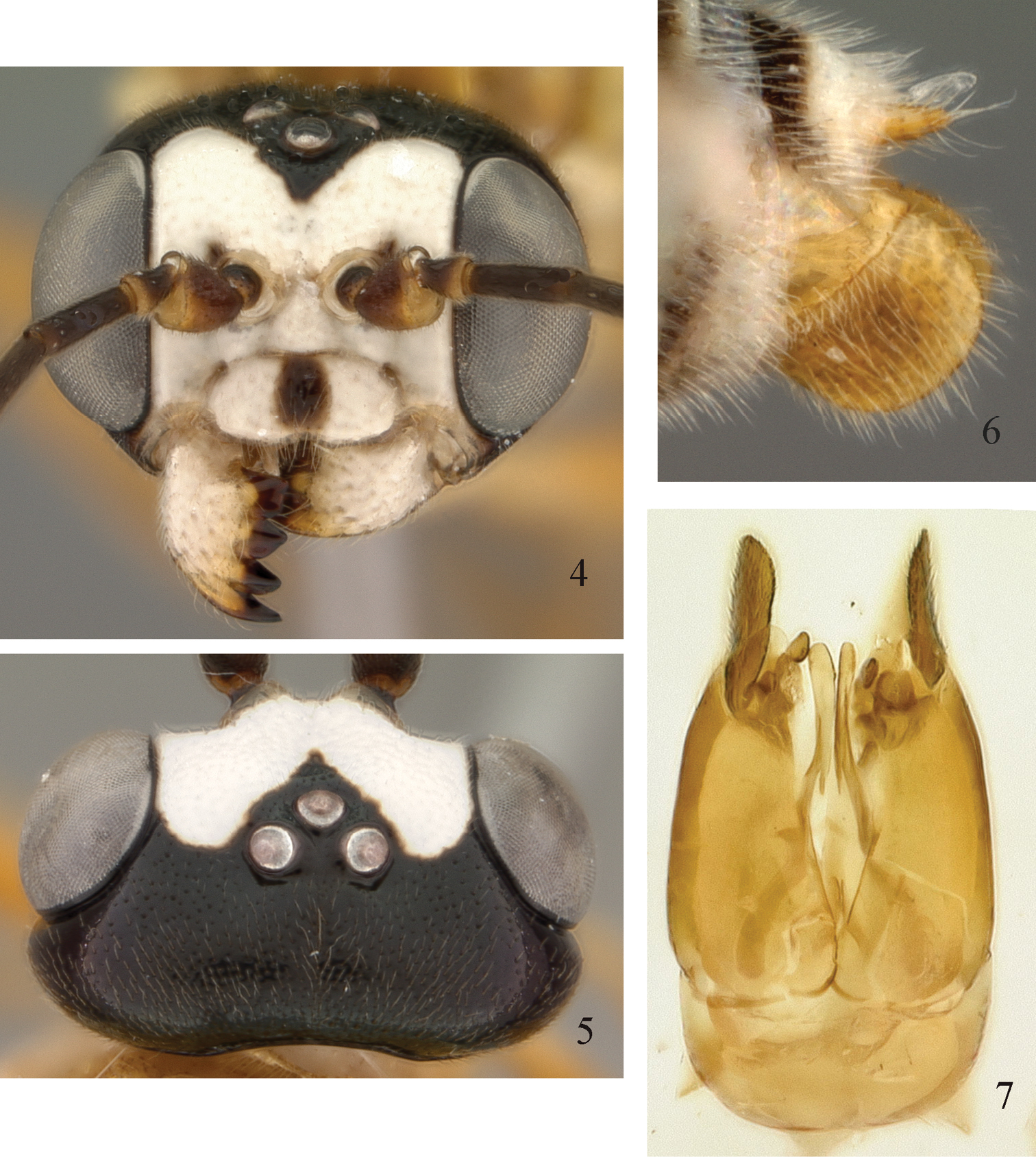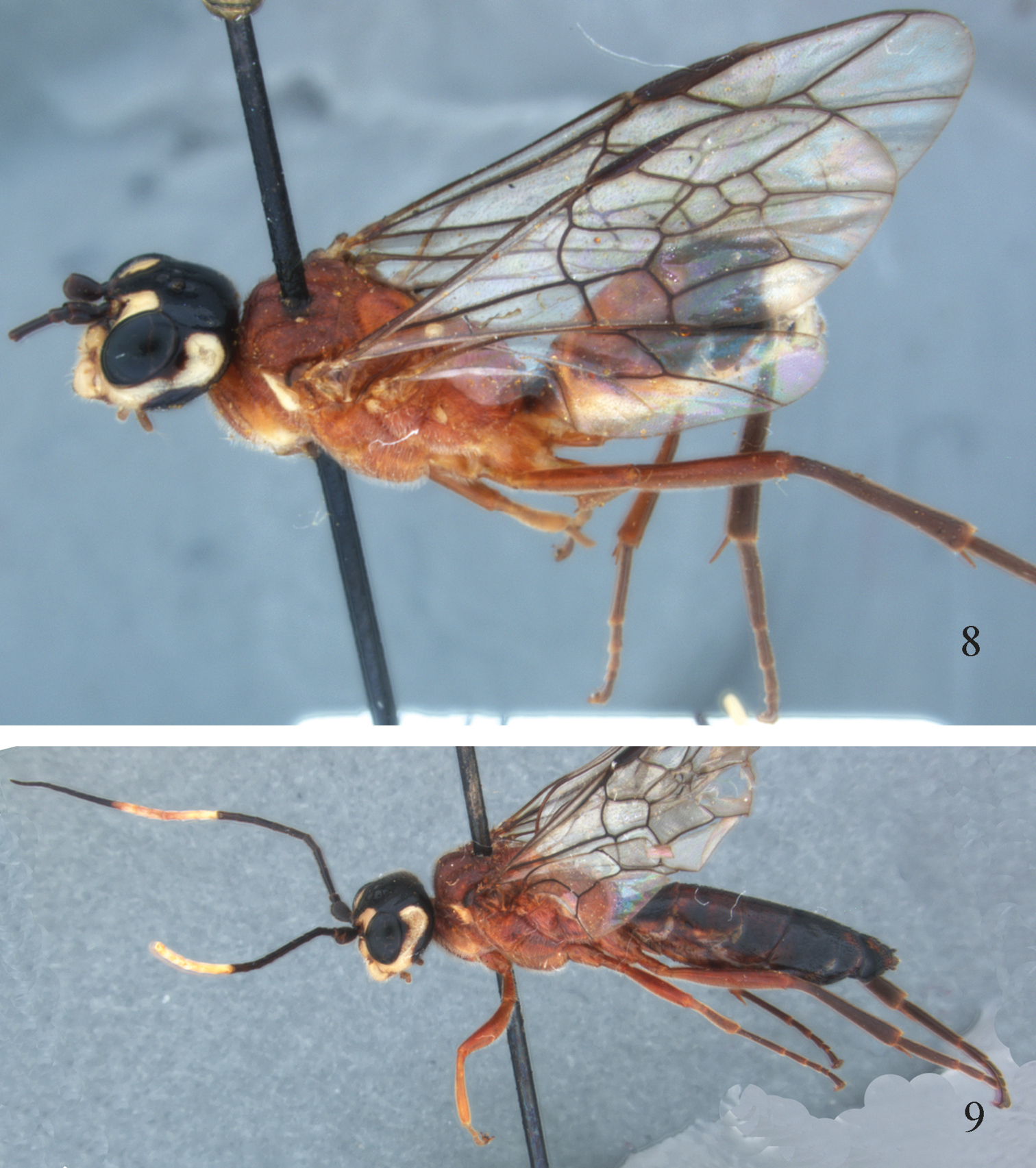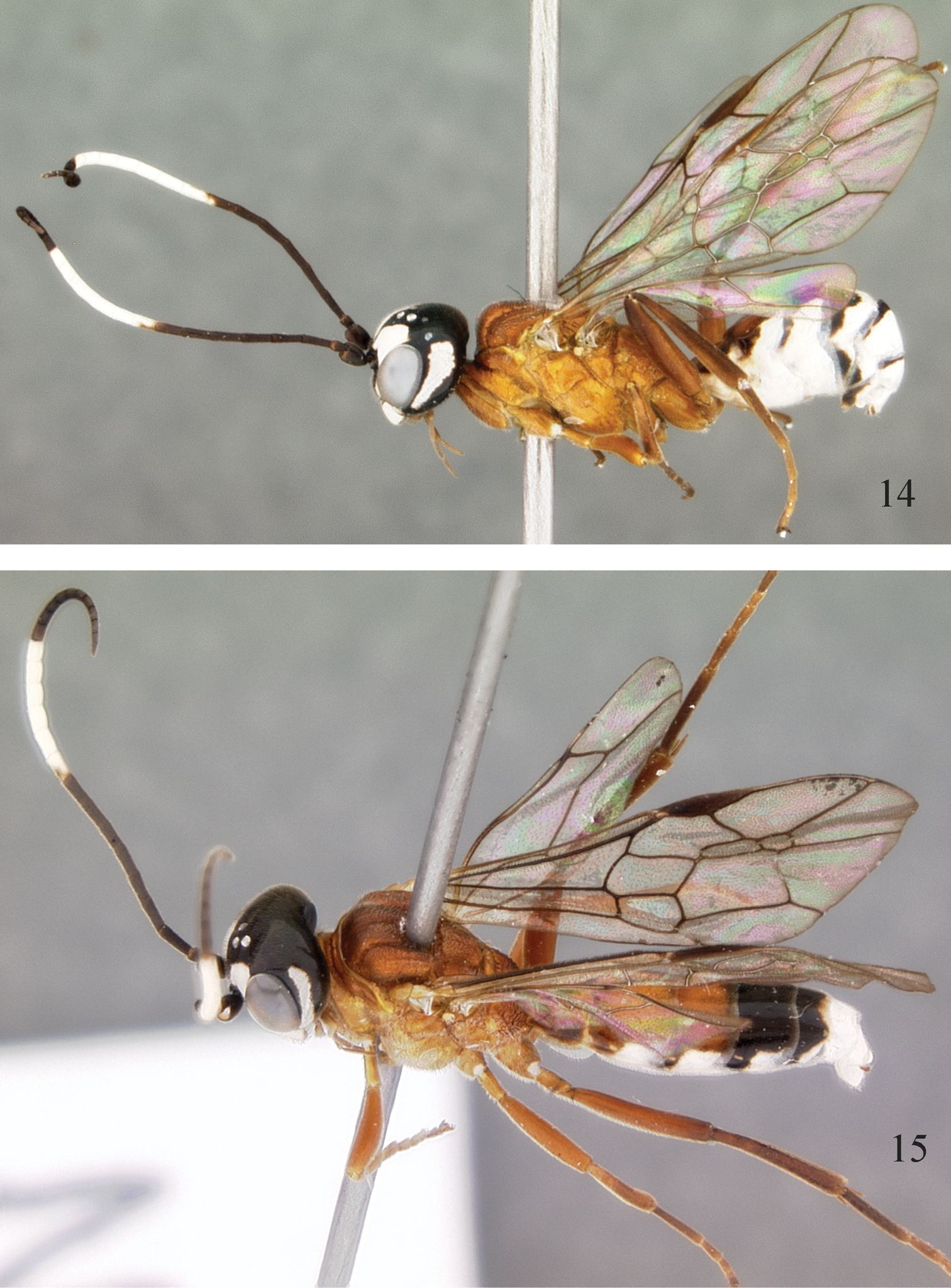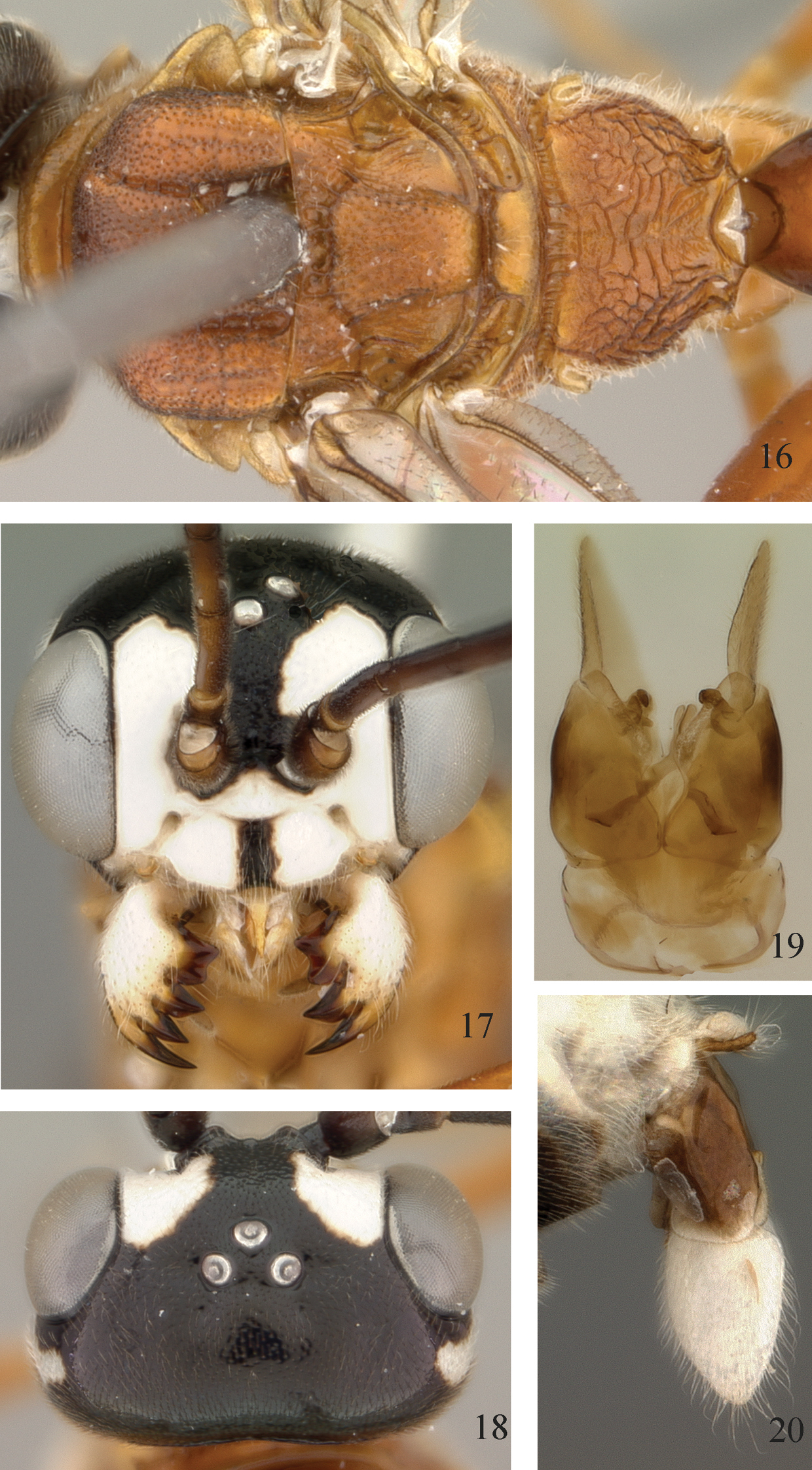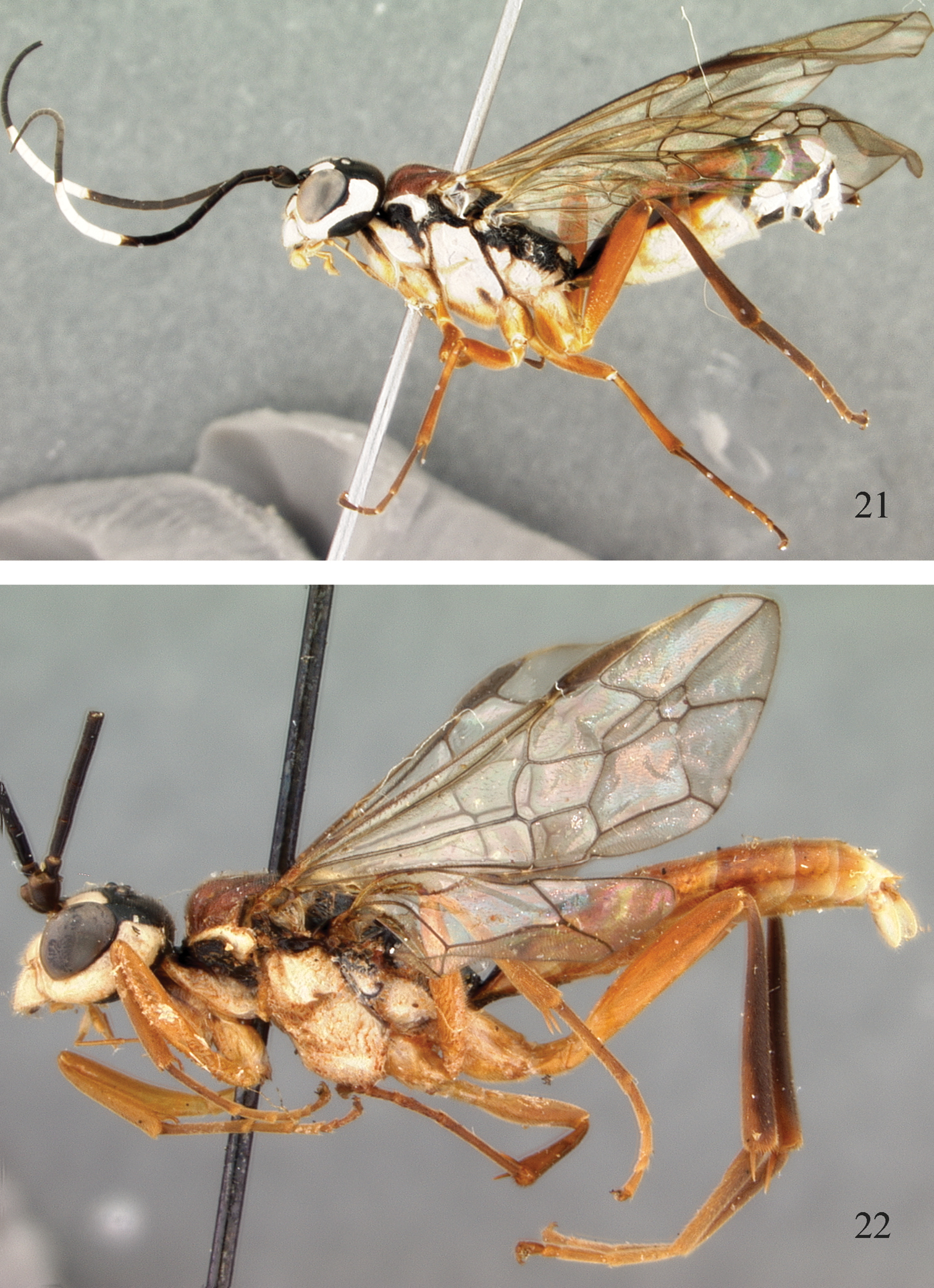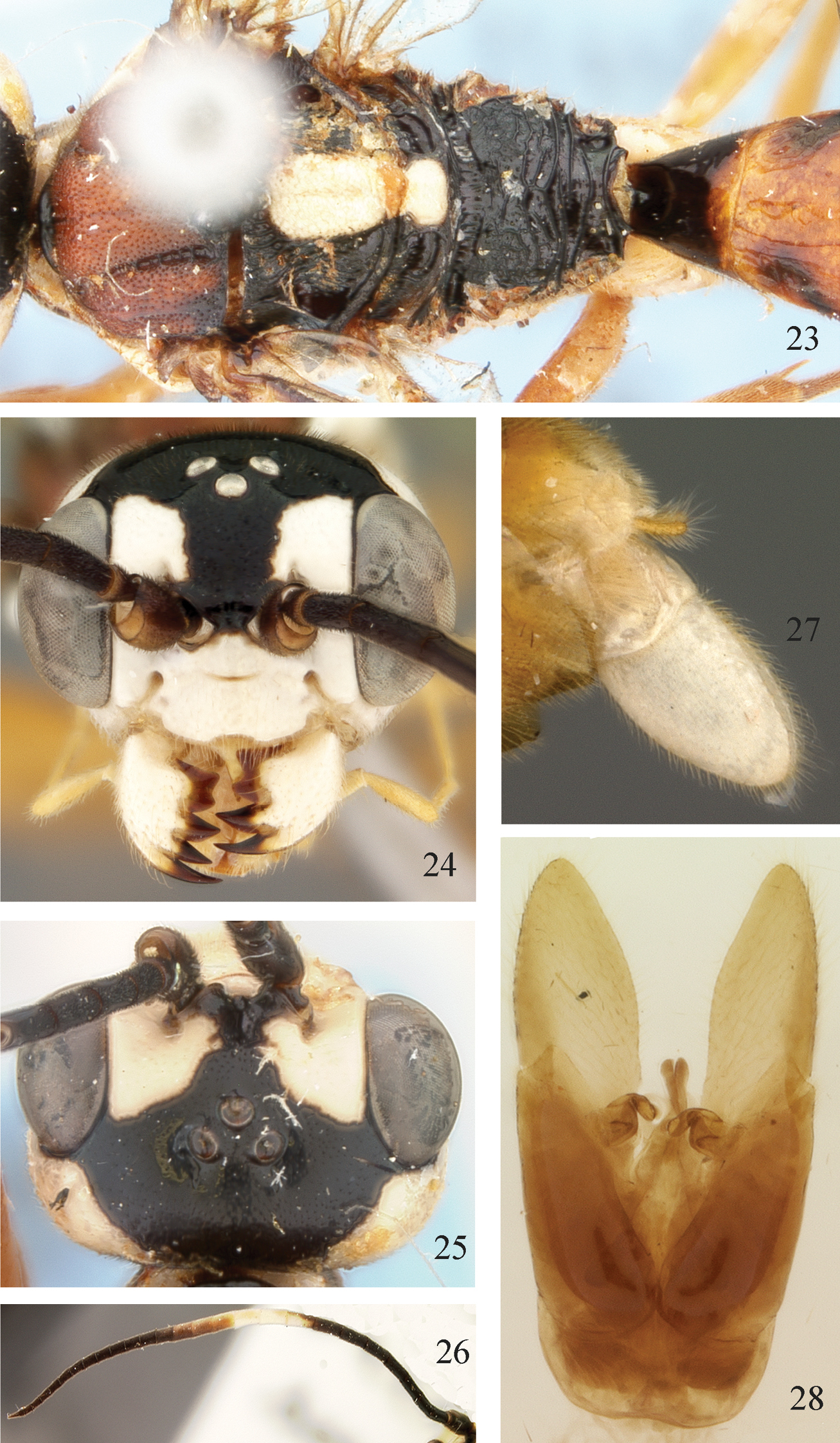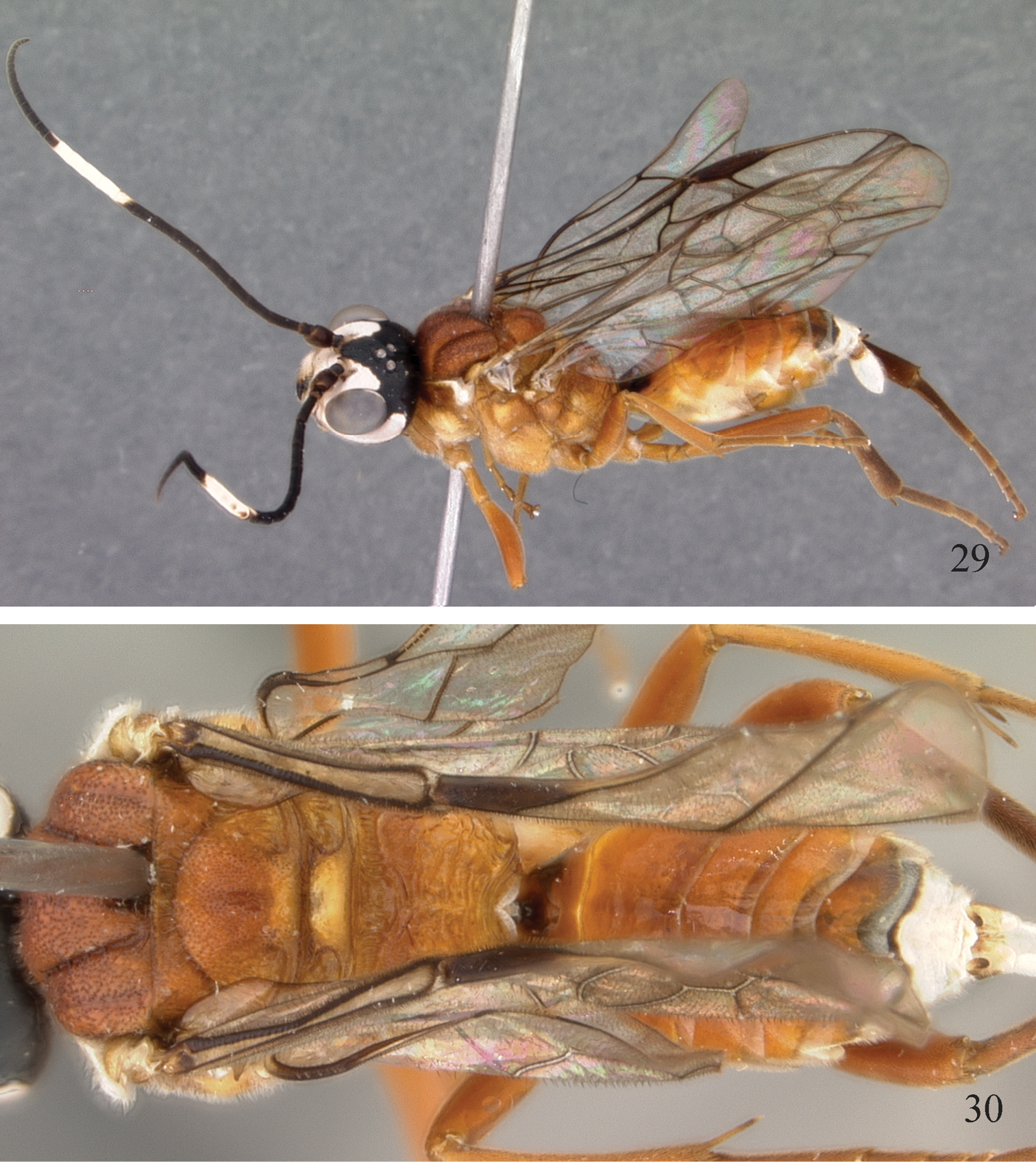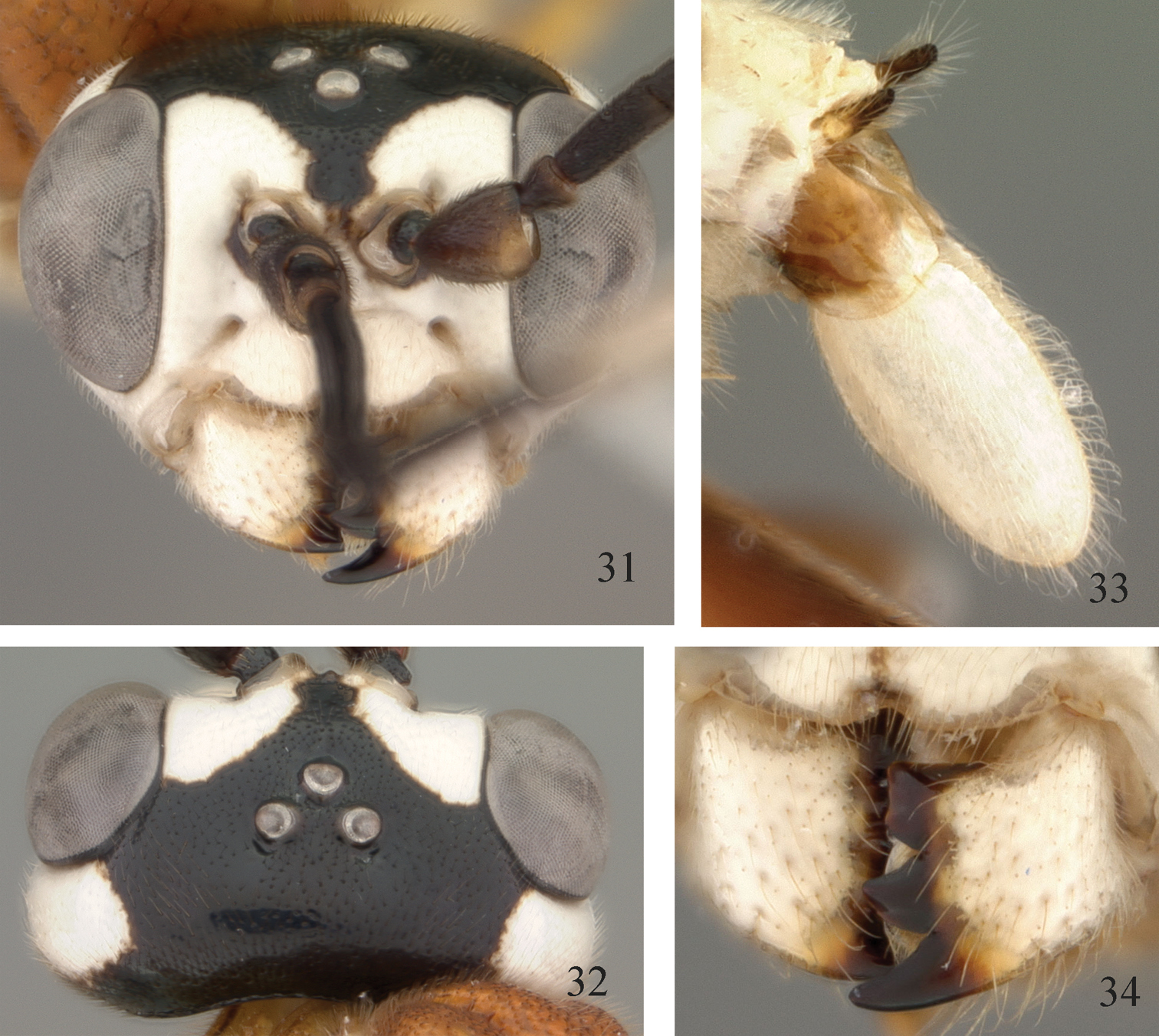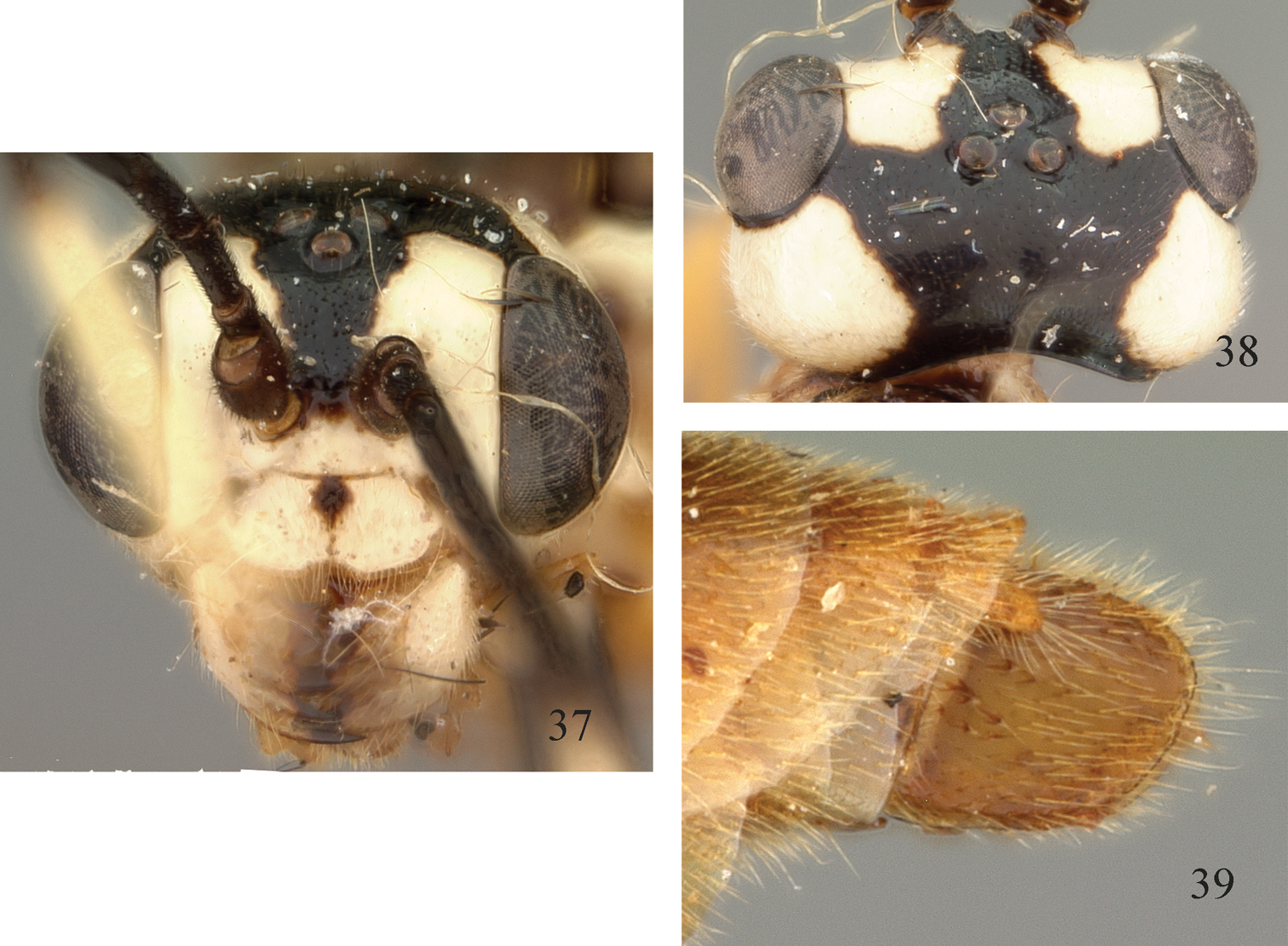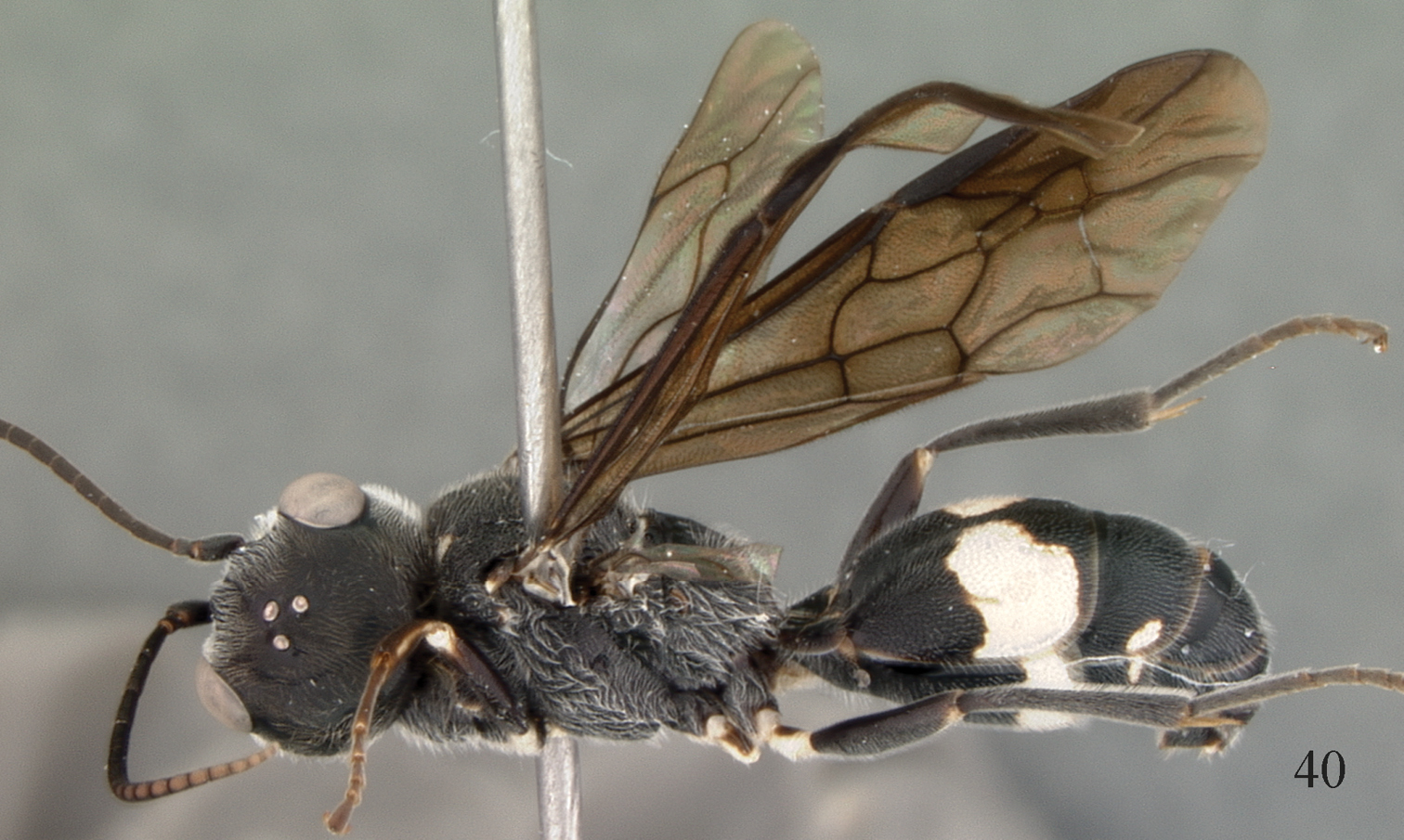






(C) 2012 David R. Smith. This is an open access article distributed under the terms of the Creative Commons Attribution License 3.0 (CC-BY), which permits unrestricted use, distribution, and reproduction in any medium, provided the original author and source are credited.
For reference, use of the paginated PDF or printed version of this article is recommended.
Seven species of the primarily hyperparasitoid family Trigonalidae are reported from Madagascar: Orthogonalys brevis Smith & Tripotin, sp. n., Orthogonalys gigantea Benoit, 1951; Orthogonalys hova Bischoff, 1933; Orthogonalys maculata Bischoff, 1933; Orthogonalys parahova Smith & Tripotin, sp. n., Orthogonalys seyrigi Bischoff, 1933; and Trigonalys natalensis Kriechbaumer, 1894. Diagnoses and a key to species are given.
Afrotropical, hyperparasitoids
Other than original descriptions and catalogs, no work has been done on the trigonalid fauna of Madagascar. In the most recent list by
Trigonalidae are hyperparasitoids mostly of Ichneumonidae (Hymenoptera) and Tachinidae (Diptera) parasitizing Lepidoptera caterpillars and social wasps (
Trigonalids have been recorded from the provinces of Antsiranana, Fianarantsoa, Majunga, Toamasina, and Toliara and probably occur throughout Madagascar.
Materials and methodsImages were obtained using an EntoVision Imaging Suite that included a firewire JVC KY-75 3CCD digital camera mounted to a Leica M16 zoom lens via a Leica z-step microscope stand. Multiple focal planes were merged using Cartograph 5.6.0 (Microvision Instruments, France) software.
Specimens used in this study are deposited in the California Academy of Sciences, San Francisco, USA (CAS); Museum für Naturkunde, Humboldt-Universität, Berlin, Germany (MNHU); Muséum National d’Histoire Naturelle, Paris, France (MNHN); National Museum of Natural History, Smithsonian Institution, Washington, DC, USA (USNM); and the collection of Pierre Tripotin, Mont Saint-Aignan, France (PT).
Locality data are recorded essentially as they appear on the specimen labels. Characterization of genera and validity of generic names was treated by
Madagascar previously was divided into six provinces and 22 regions. The 22 regions became the highest subdivisions in 2007 (http://en.wikipedia.org/wiki/Madagascar). All label data, as well as distributions reported in the literature, are according to the original six provinces, which are used in this paper.
ResultsKey to species
| 1 | Antenna black; mesosoma and metasoma predominantly black; wings darkened (Fig. 40) | Trigonalys natalensis |
| – | Antenna with white central band; mesosoma and usually metasoma predominantly orange to yellow, metasoma commonly partly black dorsally; wings hyaline (Figs 1, 8, 14, 15, 21, 29, 35) (Orthogonalys) | 2 |
| 2 | Mesosoma black posterior to transscutal articulation, mesoscutellum and metascutellum white (Figs 23, 36) | 3 |
| – | Mesosoma orange, mesoscutellum and metascutellum may be yellow (Figs 3, 10, 16, 30) | 4 |
| 3 | Mesoscutellum slightly longer than broad, anterior width about 0.8× medial length (Fig. 23); hind tibia brown to black, darker than orange femur and tarsus (Figs 21, 22); only about 3 or 4 central antennomeres completely white (Fig. 26); first metasomal tergum partly black (Fig. 23); paramere of male genitalia oval, about 1.5× as long as broad, white (Figs 27, 28) | Orthogonalys maculata |
| – | Mesoscutellum about as long as broad, anterior width about 1.1× medial length (Fig. 36); hind legs orange (Fig. 35); about 6 central antennomeres completely white (as in Figs 2, 14); first metasomal tergum orange (Figs 35, 36); paramere of male genitalia short, almost round and as long as broad, brown (Fig. 39) | Orthogonalys seyrigi |
| 4 | Frons completely white, not interrupted in center by broad, black band (Fig. 4) or interrupted by a very narrow black line; gena black (Figs 1, 2); paramere of male genitalia short, round, slightly broader than long, brown (Fig. 6), less than half length of gonostipes (Fig. 7); about 5–8 mm long | Orthogonalys brevis sp. n. |
| – | Frons interrupted in middle by broad black stripe (Figs 11, 17, 31); gena mostly white (Figs 8, 14, 29); paramere of male genitalia elongate, 1.4–1.8× as long as broad, white or dark orange (Figs 13, 20, 33), more than half length of gonostipes (Fig. 19); size various | 5 |
| 5 | Propodeum with transverse carinae (Fig. 10); paramere of male genitalia orange brown, about l.4× as long as broad, rounded at apex (Fig. 13); large, 14–15 mm long | Orthogonalys gigantea |
| – | Propodeum with irregular reticulate sculpture (Figs 16, 30); paramere of male genitalia white, about 1.5× as long as broad, tapering to acutely rounded apex (Fig. 20) or about 1.8× as long as broad and broadly rounded at apex (Fig. 33); small, 4–11 mm long | 6 |
| 6 | Mesoscutellum slightly broader than long, anterior width 1.2× medial length (Fig. 30); about 4 central antennomeres completely white; clypeus white; metascutellum yellow (Fig. 30); metasomal tergites 2–5 mostly orange (Figs 29, 30); paramere of male genitalia 1.8× as long as broad and rounded at apex (Figs 29, 33); larger, 10 mm long; only male known | Orthogonalys parahova, sp.n. |
| – | Mesoscutellum slightly longer than broad, anterior width about 0.9× medial length (Fig. 16); 6 or 7 central antennomeres completely white; clypeus with broad, black median stripe (Fig. 17); metascutellum orange, as rest of mesosoma; metasomal tergites 2–4 largely black (Fig. 14, 15); paramere of male genitalia about 1.5× as long as broad and tapering to acutely rounded apex (Fig. 20); smaller, 4 – 9 mm long, most ranging near 7 mm; female and male | Orthogonalys hova |
urn:lsid:zoobank.org:act:B4FFC8CA-72FF-43FB-854B-E8C5E9E58802
http://species-id.net/wiki/Orthogonalys_brevis
Figs 1–7male, labeled “PROVINCE TOAMASINA: Montagne d'Anjanaharibe, 18.0 km 21° NNE Ambinanitelo, elev 470 m, 8–12 Mar 2003, 15°11'18"S, 049°36'54"E”, “California Acad. of Sciences, coll. Fisher, Griswold et al., Malaise trap, in rainforest, collection code BLF8011" (CAS).
Same data as for holotype (1 ♀, 1 ♂, CAS, USNM); “PROVINCE ANTSIRANANA: Marojejy Nat'l Park, 5 km W Manantenina village, Camp Mantella, 28 April – 7 May 2005, 14°26.29'S, 49°46.44'E”, “California Academy of Sciences, coll: M. Irwin, R. Harin'Hala, Malaise trap, low altitude rainforest, elev. 490 m, MA-31-20" (1 ♂, CAS), same except “26 Sept.- 4 Oct. 2005, MA-31-32" (3 ♂, CAS, USNM); same except “28 Aug. – ll Sept. 2005, MA-31-29" (1 ♂, USNM). “PROVINCE ANTSIRANANA: Parc National de Marojejy, Manantenina River, 26.6 km 35° NNW Manantenina, 11–14 Dec 2005, 14°26'06"S, 049°45'36"E, " “California Acad. of Sciences, coll. B. L. Fisher et al., elev. 775 m, Malaise trap, rainforest, collection code BLF 13385" (3 ♂, CAS, USNM, PT). “PROVINCE ANTSIRANANA: Parc National de Marojejy, Manantenina River, 28.0 km 38° NE Andapapa, 8.2 km 333° NNW Manantenina, el 450 m, 12–25 November 2003, " “14°26'12"S, 049°46'30"E, California Acad. of Sciences, coll. B. L. Fisher et al., Malaise trap in rainforest, BLF 8723" (1 ♂, CAS).
Female (Fig. 1). Length. 7.0 mm. Similar to male except for penultimate metasomal segment and sheath black, and genitalic characters.
(Fig. 2). Length. 5.0–8.0 mm. Antenna black, antennomeres 9–16 and sometimes 17 white. Head white with vertex and gena black, black extending anteriorly as V-shaped mark in front of ocelli; broad black median stripe on clypeus (Figs 4, 5). Mesosoma pale orange. Legs pale orange with hind tibia and tarsus darker to black. Wings hyaline, veins brown, costa more orange toward base; stigma brown to orange with anterior margin black. Genitalia brown.
Antenna with 28 antennomeres. Head from above slightly concave behind, distance behind eyes about 0.7× eye length (Fig. 5). Metascutellum broader than long, anterior breadth about 1.3× medial length; metascutellum about 2.0× broader than long (Fig. 3). Dorsum of mesosoma shiny, with widely spaced small punctures farther apart than 2–3× puncture diameters. Propodeum coarsely reticulate (Fig. 3). Male genitalia with paramere short, 1.6× broader than long, broadly rounded at apex, about 0.5× length of gonostipes (Figs 6, 7).
Orthogonalys brevis. 1 Female paratype, lateral view. 2 Male paratype, lateral view. 3 Mesosoma and metasoma, male, dorsal view.
Orthogonalys brevis, male paratype. 4 Head, front view. 5 Head, dorsal view. 6 Apex of abdomen and genitalia, lateral view. 7 Genitalia, dorsal view.
Madagascar: Antsiranana, Toamasina.
The specific name is from the Latin brevis, referring to the short parameres of the male genitalia.
The short parameres of the male genitalia place this species close to Orthogonalys seyrigi; however, the parameres of Orthogonalys brevis are shorter and broader than long whereas those of Orthogonalys seyrigi are about as broad as long (Figs 6, 39) The color of Orthogonalys brevis is entirely different than in Orthogonalys seyrigi and more similar to that of Orthogonalys hova with the almost entirely orange mesosoma and metasoma. The color of the head is consistently different than in other Orthogonalys species with more white across the frons, which is not interrupted with black, except sometime for a very narrow medial line, and the entirely black gena (Figs 4, 5). The metasoma of Orthogonalys brevis is almost entirely orange with only apical segment white and the penultimate segment mostly black.
http://species-id.net/wiki/Orthogonalys_gigantea
Figs 8–13Holotype female at MNHN, labeled “Muséum Paris, ” “Madagascar, Mgn l’Ambre, ” “Muséum Paris 1.34 A. Seyrig, ” “TYPE [red], ” “Orthogonalys gigantea sp. n. holotype ♀, det. P. L. G.
PROVINCE ANTSIRANANA: “Madagascar Nord, dct Diégo-Suarez, Analamerana, 80 m, 50 km SE Diégo, I-59, Andria R.” (1 ♂, MNHN).
Female (Fig. 8). Length, 14 mm. Head black; inner orbits broadly from top of eye through malar area and gena, clypeus except for median V-shaped stripe, and mandible except apex white (Figs 11, 12). Mesosoma orange with hind corners of pronotum, lower anterior corner of pronotum, and metascutellum yellow. Legs dark orange; hind tibia and tarsus darker, nearly black. Metasoma dark orange with black spot at center of 1st tergite, small faint black spot at center of 2nd tergite, lateral and posterior bands on 3rd tergite, and most of tergite 4 except for white posterior margin; tergite 5 white; laterally and ventrally mostly yellow with black spot on 6th sternite and sheath black.
Antenna missing (see male). Head from above nearly straight behind, behind eyes slightly expanded, distance behind eyes about equal to eye length (Fig. 12). Anterior width of mesoscutellum 0.8× medial length. Metascutellum 2× broader than long (Fig. 10). Mesonotum shiny with closely set punctures, mostly separated by shiny interspaces 1–2× puncture diameters. Propodeum with almost straight transverse carinae (Fig. 10).
(Fig. 9). Length, 15 mm. Antenna black; antennomeres 11–16 and basal half of 17 white. Similar to female except apex of mesoscutellum more yellowish, metasoma mostly black above with reddish brown at apex of tergite 1 and on most of tergites 2 and 3, tergites 1–3 laterally and ventrally orange yellow and tergites 4–6 with white spots. Paramere dark orange.
Antenna with 28 antennomeres, otherwise similar to female. Paramere oval, about 1.4× as long as broad, broadly rounded at apex (Fig. 13).
Orthogonalys gigantea. 8 Female holotype, dorsolateral view. 9 Male, dorsolateral view.
Orthogonalys gigantea. 10 Mesosoma, dorsal view, male. 11 Head front view, female holotype. 12 Head, dorsal view, female holotype. 13 Male paramere, lateral view (appearance is due to hairs matted against the surface).
Madagascar: Antsiranana.
The status of this species has been questionable.
After study of both sexes, we note a number of characters that justify treating Orthogonalys gigantea as a valid species. Size cannot be regarded as a valid character in trigonalids. However, in comparison to Orthogonalys hova, the specimens examined are consistently larger. The female holotype of Orthogonalys gigantea is 14 mm and the male is 15 mm, whereas the largest Orthogonalys hova female is 9 mm and males 5.0–9.5 mm, with most in the 7 mm range. We are not sure about the clypeus, mandible, punctation of the scutellum, and closeness of the antennal sockets as Benoit described; these do not seem significant. However, we emphasize the following characters: the sculpture of the propodeum of Orthogonalys gigantea is more transverse (Fig. 10) than the more reticulate sculpture of Orthogonalys hova (Fig. 16) and other Orthogonalys species; the color of both are similar, except that Orthogonalys gigantea has the metascutellum yellow and the male has the metasomal tergites mostly black whereas the metascutellum of Orthogonalys hova is orange and the metasomal tergites of the male are considerably orange; and the parameres of Orthogonalys gigantea are dark orange and rounded at the apex (Fig. 13), whereas those of Orthogonalys hova are white and more acute at the apex (Fig. 20).
This species is known only from northern Madagascar. The holotype and associated male were collected in the same area, around Diego Suarez, the two localities only about 50 km apart.
http://species-id.net/wiki/Orthogonalys_hova
Figs 14–20
PROVINCE FIANARANTSOA: Parc National Ranomafana, Belle Vue at Talatakely, elev. 1020 m, 10–21 March 2003, 21°15.99'S, 47°25.21'E, coll. M. Irwin, R. Harin'Hala, California Acad. of Sciences, Malaise, secondary tropical forest, MA-02-09C-56 (5 ♂); same data except following dates and code numbers: 15–28 May 2003, MA-02-09C-61 (6 ♂); 21 March – 12 April 2003, NA-02-09C-57 (4 ♂); 12–23 April 2003, MA-02-09C-58 (1 ♂); 28 May – 6 June 2003, MA-02-09C-62 (7 ♂); 6–18 June 2003, MA-02-09C-63 (3 ♂); 12–23 April 2003, MA-02-09C-58 (1 ♂); 16–26 February 2003, MA-02-09C-54 (3 ♂); 8–15 November 2001, MA-02-09C-02 (4 ♂); 28 Nov. – 8 Dec. 2001, MA-02-09C-05 (3 ♂); 15–21 Dec. 2001, MA-02-09C-07 (1 ♂); 16 Oct. – 8 Nov. 2001, MA-02-09C-01 (6 ♂); 14–24 July 2002, MA-02-09C-35 (1 ♂); 28 April – 5 May 2002, MA-02-09C-27 (2 ♂). Parc National Ranomafana, radio tower at forest edge, elev. 1130 m, 18–29 June 2003, 21°15.05'S, 47°24.43'E, coll.: M. Irwin, R. Harin'Hala, California Acad. of Sciences, Malaise, mixed tropical forest, MA-02-09B-64 (4 ♂); same data except following dates and code numbers: 7–18 June 2003, MA-02-09B-63 (5 ♂); 7–17 May 2003, MA-02-09B-60 (4 ♂); 27 April – 7 May 2003, MA-02-09B-59 (5 ♂); 3–16 April 2003, MA-02-09B-57 (1 ♂); 20 March – 3 April 2003, MA-02-09B-56 (3 ♂); 9–20 March 2003, MA-02-09B-55 (8 ♂); 18–27 February 2003, MA-02-09B-53 (10 ♂); 27 June – 7 July 2003, MA-02-09B-65 (5 ♂); 6–17 July 2003, MA-02-09B-66 (8 ♂); 17–30 May 2003, MA-02-09B-61 (10 ♂); 15–27 April 2003, MA-02-09B-58 (8 ♂); 27 Feb. – 9 March 2003, MA-02-09B-64 (2 ♂); 14–24 June 2002, MA-02-09B-32 (3 ♂). Manombo Special Reserve, camp site, 32 km SSE of Farafangana, 20 Jan – 2 Feb. 2005, 23°01.31'S, 47°43.20'E, California Acad. of Sciences, coll: M. Irwin, R. Harin'Hala, Malaise trap, lowland rainforest, elev. 36 m, MA-28-11 (1 ♂). Ranomafana JIRAMA waterworks, 15–22 November 2001, 21°14.91'S, 47°27.13'E, coll.: M. Irwin, R. Harin'Hala, California Acad. of Sciences, Malaise trap near river, elev. 690 m, MA-02-09D-03 (1 ♂); Parc National Ranomafana, Vohiparara, at broken bridge, 1110 m, 15–25 July 2002, 21°13.57'S, 47°22.19E, coll: M. Irwin, R. Harin'Hala, California Acad. of Sciences, Malaise trap in high altitude rainforest, MA-02-09A-35 (2 ♂); same data except following dates and code numbers: 14–21 January 2002, MA-02-09A-12 (1 ♂); 15–21 December 2001, MA-02-09A-07 (1 ♀, 1 ♂). PROVINCE TOAMASINA: Rogez (type locality; holotype and paratypes). PROVINCE TOLIARA: Parc National de Zombitse, 19.8 km 84° E Sakaraha, elev. 770 m, 5–9 Feb. 2003, 22°50'36"S, 044°42'36"E, coll. Fisher, Griswold et al., California Acad of Sciences Malaise trap, in tropical dry forest, coll. Code BLF 7506 (1 ♀). Réserve Spéciale, Kalambatritra, Ampenihy, 23°27'49"S, 046°27'47"E, 9–10 February 2009, Calif. Acad. of Sciences, coll: B. L. Fisher et al., Malaise trap, montane rainforest, elev. 1270 m, BLF 21564 (1 ♂). Deposited at CAS, USNM, PT, MNHU, MNHN.
Female (Fig. 14). Length, 7.0–9.0 mm Similar to male except metasoma more extensively white; mostly black on tergites 1 and 2, with decreasing amount of black toward apex.
(Fig. 15). Length, 4.0–9.5 mm. Antenna black, antennomeres 9–15 white and sometimes apex of 8. Head white with vertex black, with black extending to dorsal margins of eyes, partly down outer orbits, down outer margin of gena and broad stripe medially to antennal sockets (Figs 17, 18). Clypeus with median broad black stripe (Fig. 17). Mesosoma orange. Legs orange. Wings hyaline with veins and stigma black. Metasoma with tergites 1–3 orange to reddish brown, tergites 4 and 5 black and narrowly white at apices of tergites 5 – 7; tergites 2–5 with white lateral spots; sternites white except 4 and 5 with narrow black anterior margins. Male genitalia with gonostipes brown, paramere white.
Antenna with 26–28 antennomeres. Head from above almost straight behind, distance behind eyes about 0.8× eye length, with scattered fine punctures (Fig. 18). Mesoscutellum with anterior width slightly shorter than medial length. Metascutellum 2× broader than long. Propodeum with coarse reticulate sculpture (Fig. 16). Mesonotum shiny with small punctures separated by flat shiny interspaces mostly 2× or more puncture diameters. Male genitalia with paramere about 1.5× as long as broad, narrowing to acutely rounded apex (Fig. 20), about 0.8× length of gonostipes (Fig. 19).
Orthogonalys hova. 14 Female, lateral view. 15 Male, dorsolateral view.
Orthogonalys hova, male. 16 Mesosoma, dorsal view. 17 Head, front view. 18, Head, dorsal view. 19 Genitalia, dorsal view. 20 Apex of abdomen and genitalia, lateral view.
Madagascar: Antananarivo (Ankaratra,
See discussion under Orthogonalys gigantea for characters separating the two species. This is the most commonly collected species in Madagascar and occurs from the lowlands to high altitude rainforests. We have examined about 130 specimens.
http://species-id.net/wiki/Orthogonalys_maculata
Figs 21–28Holotype male at MNHU, labeled “O. –Madagaskar, Rogez 11.32, Seyrig S.” “Orthogonalos seyrigi f. maculata Bisch. Type ♂ 1933, det. Bischoff” “TYPUS” “Zool. Mus. Berlin.”
PROVINCE ANTSIRANANA: Marojejy Nat'l Park, 5 km W Manantenina village, Camp Mantella, 18–30 May 2005, 14°26.29'S, 49°46.44'E, California Academy of Sciences, coll: M. Irwin, R. Harin'Hala, Malaise trap, low altitude rainforest, elev. 490 m, MA-31-22 (1 ♂); same data except 4–16 April 2005, MA-31-18 (1 ♂). PROVINCE FIANARANTSOA: Parc National Ranomafana, Belle Vue at Talatakely, elev. 1020 m, 16 Oct – 8 Nov. 2001, 21°15.99'S, 47°25.21'E, coll. M. Irwin, R. Harin'Hala, California Acad. of Sciences, Malaise, secondary tropical forest, MA-02-09C-01 (3 ♂); same data except follow dates and code numbers: 19–26 February 2002, MA-02-09C-17 (2 ♂); 21 March – 12 April 2003, MA-02-09C-57 (3 ♂); 10–21 March 2003, MA-02-09C-56 (1 ♂); 6–18 June 2003, MA-02-09C-63 (1 ♂). Parc National Ranomafana, radio tower at forest edge, elev. 1130 m, 6–17 July 2003, 21°15.05'S, 47°24.43'E, coll.: M. Irwin, R. Harin'Hala, California Acad. of Sciences, Malaise, mixed tropical forest, MA-02-09B-66 (1 ♀); same data except following dates and code numbers: 20 March – 3 April 2003, MA-02-09B-56 (1 ♂); 7–17 May 2003, MA-02-09B-60 (1 ♂). Ranomafana JIRAMA waterworks, 10–14 January 2002, 21°14.91'S, 47°27.13'E, coll.: M. Irwin, R. Harin'Hala, California Acad. of Sciences, Malaise trap near river, elev. 690 m, MA-02-09D-11 (1 ♂). PROVINCE TOAMASINA: Rogez (type locality, holotype ♂). Deposited in CAS, USNM, PT, MNHU.
Female (Fig. 21). Length, 14 mm. Similar to male except metasoma white laterally and ventrally and tergites 1–4 mostly black dorsally, 5 and 6 black anteriorly.
(Fig. 22). Length, 8.5–12.0 mm. Antenna black with antennomere 10 white at apex, 11–12 completely white, and 13–15 partly brown on lower surface and white on upper surface (Fig. 26) or 11–14 completely white. Head white with vertex black, black extending to dorsal margin of eyes, down posterior margin of gena, and anteriorly onto frons to antennal sockets (Figs 24, 25). Mesosoma anterior to transscutal articulation red, posterior to transscutal articulation black with mesoscutellum and metascutellum white; pronotum with anterolateral margins white and laterally white with broad black intermediate stripe; mesopleuron and mesosternum mostly white with black on dorsal margin and margins of mesepimeron black; metapleuron mostly white. Legs orange with hind tibia and basal half of basitarsomere darker, hearly black. Wings hyaline; veins and stigma black. Metasoma mostly orange; tergite 1 mostly black, tergites 2–6 orange with black spots at apices of tergites 5 and 6 and sometimes laterally on tergites 2 and 4, and apical tergite white. Male genitalia with gonostipes brown and paramere white.
Antenna with 28–29 antennomeres. Head from above nearly straight behind; distance behind eyes about 0.7× eye length (Fig. 25). Mesoscutellum as long as broad, anterior width 0.8× medial length; metascutellum about 1.4× broader than long. Propodeum with coarse reticulation anteriorly, 4 or 5 irregular transverse carinae posteriorly (Fig. 23). Mesonotum shiny, with fine punctures mostly separated by shiny interspaces 3× or more than puncture diameters. Male genitalia with paramere about 1.5× as long as broad, broadly rounded apically (Fig. 27); subequal to length of gonostipes (Fig. 28).
Orthogonalys maculata. 21 Female, lateral view. 22 Male holotype, lateral view.
Orthogonalys maculata, male. 23 Mesosoma, dorsal view. 24 Head, front view. 25 Head, dorsal view. 26 Antenna. 27 Apex of abdomen and genitalia, lateral view. 28 Genitalia, dorsal view.
Madagascar: Antsiranana, Fianarantsoa, Toamasina.
The color of Orthogonalys maculata is almost identical to Orthogonalys seyrigi, which probably led to its description only as a form of that species by
urn:lsid:zoobank.org:act:99FB8068-7C7D-4C21-B2C8-EE08997CD0FA
http://species-id.net/wiki/Orthogonalys_parahova
Figs 29–34Male, labeled “Madagascar, Fianarantsoa, Parc National Ranomafana, Belle Vue at Talatakely, elev. 1020 m, 15–28 May 2003, ” “21°15.99'S, 47°25.21'E, coll. M. Irwin, R. Harin’Hala, California Acad. of Sciences, Malaise, secondary tropical forest, MA-02-09C-61” (CAS).
“Madagascar, Fianarantsoa, Miandritsara Forest, 40 km S Ambositra, 20°47.56'S, 47°10.54'E, 5–19 March 2005, ” “California Acad. of Sciences, coll: M. Irwin, R. Harin’Hala, Malaise trap, in low altitude rainforest, elev. 825 m, MA-29-11” (1 ♂, CAS).
Female. Unknown.
(Fig. 29). Length, 10.0 -11.0 mm. Antenna black; antennomeres 11 at apex, 12–15, and base of 16 white. Head white with vertex and upper frons black, black extending to dorsal margins of eyes and medially to near antennal sockets (Figs 31, 32); clypeus white. Mesosoma orange with posterior lateral angles of pronotum white and metascutellum yellow; pleura and sterna lighter orange than dorsum. Legs orange with hind tibia and tarsus black. Wings hyaline with veins and stigma black. Metasoma with tergite 1 mostly black, tergites 2–4 orange, tergite 5 mostly black, and tergites 6 and 7 white, narrow lateral edges of tergites white and sternites mostly white; genitalia with gonostipes brown and paramere white.
Antenna with 28–29 antennomeres. Head from above slightly emarginated behind; head behind eyes about 0.8× eye length (Fig. 32). Anterior width of mesoscutellum about 1.2× medial length; shallow, median longitudinal groove on posterior half (Fig. 30). Metascutellum 2× broader than long. Mesonotum shiny with closely set punctures, mostly separated by shiny interspaces 1 – 2× puncture diameters. Propodeum with irregular transverse carinae at center, more reticulate on sides (Fig. 30). Paramere of male genitalia about 1.8× as long as broad, broadly rounded at apex (Fig. 33), subequal in length to gonostipes (as in Fig. 28).
Orthogonalys parahova, holotype male. 29 Dorsolateral view. 30 Mesosoma and metasoma, dorsal view.
Orthogonalys parahova, holotype male. 31 Head, front view. 32 Head, dorsal view. 33 Apex of abdomen and male genitalia, lateral view. 34, Mandibles.
From the species name “hova” with the Greek prefix ”para” meaning resembling Orthogonalys hova.
This species is similar to Orthogonalys hova, and initially we considered the two males as large specimens of that species. However, the following differences justify its recognition as a distinct species: antenna with only about 4 central antennomeres completely white; clypeus white; genae almost completely white; posterior angles of pronotum white; mesoscutellum with anterior width about longer than medial length and with distinct median furrow in posterior half (Fig. 30); and paramere of male genitalia longer, about 1.8 times as long as broad and rounded at its apex (Fig. 33). The parameres resemble the long, rounded parameres of Orthogonalys maculata.
http://species-id.net/wiki/Orthogonalys_seyrigi
Figs 35–39
There are five paratypes at MNHN from Rogez, most in bad condition. Two are males, one with the antennae missing; one is a female, probably the only female in the original type series and the allotype designated by Bischoff, and is missing the head; two others are probably males but have the head and metasoma missing.
Female. Known by female allotype as designated by
(Fig. 35). Length, 8.0 – 9.0 mm. Antenna black with apex of 9th antennomere and antennomeres 10–15 completely white. Head white with vertex black, black narrowly extending to dorsal margin of eyes and as broad stripe anteriorly to antennal sockets; small medial black spot on dorsal margin of clypeus (Figs 37, 38). Mesosoma white laterally and ventrally with central dark stripe on pronotum; area anterior to transscutal articulation red, posterior to transscutal articulation black with mesoscutellum and metascutellum white. Legs orange with hind tibia and tarsus sometimes slightly darker orange than rest of legs. Wings hyaline; veins and stigma black. Metasoma mostly orange, base of first tergite black; lateral margins of tergites and posterior margins of sternites whiter. Male genitalia brown.
Antenna with 26 – 28 antennomeres. Head from above with posterior margin slightly concave; head behind eyes subequal to eye length (Fig. 38). Mesoscutellum with anterior width 1.1× medial length; metascutellum about 1.5× broader than long (Fig. 36). Dorsum of mesosoma shiny, with large punctures separated by 2–3× puncture diameters. Propodeum coarsely reticulate anteriorly, irregularly transversely carinate posteriorly (Fig. 36). Genitalia with paramere short, about as long as broad and broadly rounded posteriorly (Fig. 39).
Orthogonalys seyrigi, male. 35 Lateral view. 36 Mesosoma, dorsal view.
Orthogonalys seyrigi, male. 37 Head, front view. 38 Head, dorsal view. 39 Apex of abdomen and genitalia, lateral view.
Madagascar: Mahajanga (Andreba) (
The short parameres of the male genitalia (Fig. 39) relate this species to Orthogonalys brevis (Fig. 6) but in Orthogonalys seyrigi the parameres are about as long as broad, the genae are white, the white on the frons is interrupted by a broad median black stripe, and the mesosoma is red anterior to the transscutal articulation, and black posterior to it with the mesoscutellum and metascutellum white.
http://species-id.net/wiki/Trigonalys_natalensis
Fig. 40Not examined. Kriechbaumer described this species from a female from “Port Natal 24.4.93”, now Durban, South Africa. The holotype of Discenea natalensis madegassa Bischoff is in MNHU “8 ♀♀ liegen vor von Madagaskar, Bekily, I., III, IV. 1932 und Ihosy, II.-III.1933 (Seyrig S.)” “Als Typus bezeichne ich ein Stück von Bekily, IV.1932.” Three paratypes are in MNHN.
PROVINCE FIANARANTSOA: Parc National Ranomafana, Belle Vue at Talatakely, elev. 1020 m, 5–13 May 2002, 21°15.99'S, 47°25.21'E, coll. M. Irwin, R. Harin’Hala, California Acad. of Sciences, Malaise, secondary tropical forest, MA-02-09C-28 (1 ♂, CAS)
Female (Fig. 40). Length, 10.0 mm. Black with clypeus, area below antennal sockets, lower inner orbits, malar area, genae, large spots on 2nd metasomal tergite, small lateral spots on 3rd metasomal tergite, and posterior part of 2nd metasomal sternite white. Wings evenly lightly infuscated.
Madagascar: Fianarantsoa, Toliara (type locality of Discenea natalensis madegassa). Angola, Kenya, South Africa, Zimbabwe (
Schultz (1910) stated that this was reared from an unidentified lepidopteran pupa.
We have seen only one specimen and do not characterize this species further. It is readily separated from the Orthogonalys species by its black antennae, mostly black body, and infuscated wings. Two subspecies may occur in Madagascar, the typical subspecies from Madagascar, without locality, and Trigonalys natalensis madegassa from only the two localities given by
This work was supported in part by the National Science Foundation under Grant No. DEB-0072713 to B. L. Fisher and C. E. Griswold and DEB-0344731 to B. L. Fisher and P. S. Ward. Fieldwork that provided the basis for this work could not have been completed without the gracious support of the Malagasy people. We thank R. Zuparko, California Academy of Sciences, and F. Koch, Museum für Naturkunde, Humboldt-Universität, Berlin, for loan of specimens, and C. Villemant and Agniėle Touret-Alby, Muséum National d’Histoire Naturelle, for allowing study of specimens and taking images. We are thankful for the work of Michele Touchet, Systematic Entomology Laboratory, USDA, Washington, DC, for helping with the images. We appreciate the reviews of J. Prena and T. J. Henry, Systematic Entomology Laboratory, USDA, Washington, DC. USDA is an equal opportunity provider and employer.
